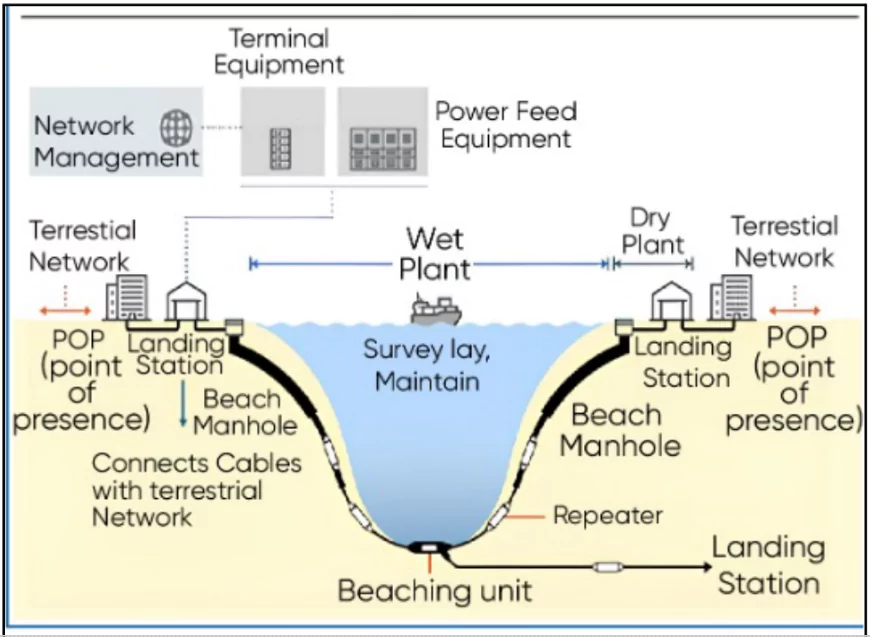Two new submarine cable systems, India Asia Xpress (IAX) and India Europe Xpress (IEX), are set to be launched adding additional Internet links between India and Asia, as well as India and Europe.
About IAX and IEX Connections
- India Asia Xpress (IAX): Connects Chennai and Mumbai with Singapore, Thailand, and Malaysia in Asia.
- India Europe Xpress (IEX): Links India with France, Greece, Saudi Arabia, Egypt, and Djibouti in Europe, the Middle East, and Africa.
Enroll now for UPSC Online Classes
About Submarine Cables (SMC)

- SMCs are fiber optic cables laid on the ocean floor and designed to transmit optical signals resulting in high bandwidth and long-distance transmission capabilities.
- Submarine cables are the foundation of global communications, enabling connectivity between continents and markets.
- Outer protective layer: Provides protection against environmental hazards such as:
- Deep-sea pressure.
- Corrosion.
- Marine activity.
- Core fibre strands: Designed for high-speed data transmission with minimal signal loss.
 Submarine Cable (SMC) Connectivity in India
Submarine Cable (SMC) Connectivity in India-
- India hosts 17 international subsea cables that connect through 14 landing stations located in cities like Mumbai, Chennai, Cochin, Tuticorin, and Trivandrum.
- Mumbai and Chennai have the highest concentration of submarine cable landing stations.
Regulation of Submarine Cable Connectivity
- The Department of Telecommunications (DoT) issues International Long-Distance (ILD) licenses to operators.
- ILD licensees, with prior approval from DoT, are authorized to:
- Set up Cable Landing Stations.
- Lay submarine cables within Indian territory.
- Internet Service Licensees under the Unified License can also:
- Install, operate, and commission International Internet Gateways using submarine cables.

About Optical Fibre
- Composition: Made of glass or plastic to transmit information as light pulses.
- Working Principle: Operates on the principle of Total Internal Reflection, where light travels through the core by continuously bouncing off the cladding.
- Data Transmission: Enables the transfer of vast amounts of data rapidly with minimal loss of optical power.
International Advisory Body for Submarine Cable Resilience (IABSR)
- IABSR is an independent advisory body established in 2021.
- It does not have a physical headquarters. It operates as a distributed body with members located in various countries.
- Objective: Its primary objective is to enhance the resilience and security of the global submarine cable network.
|
Check Out UPSC NCERT Textbooks From PW Store
Challenges in India’s Undersea Cable Network Expansion
- Physical Damages and Cyberattacks: Submarine cables are prone to physical damages from natural events or accidents. They are also susceptible to cyberattacks by state and non-state actors, raising concerns about digital security.
- Choke Points: The Malacca Strait, a key route for undersea cables connecting Mumbai and Chennai to Singapore, poses a critical vulnerability.Resilience of Infrastructure: Disruptions in March 2024 affecting three submarine cables connecting India to West Asia and Europe highlighted the need for stronger network resilience.
- Limited Connectivity Alternatives: Current solutions bypassing vulnerable regions like the Malacca Strait have not yet been developed, leaving the network reliant on these high-risk routes.
- Regional Geopolitical Dynamics: The Bangladeshi government’s recent decision to halt bandwidth sales to Northeast India adds complexity to connectivity in the region.
- Incidents like the Red Sea crisis underscore the global interconnectedness of submarine cable networks and the potential impact of disruptions in one region on others.
- Cost of Redundancy: Telcos and tech companies mitigate risks by purchasing bandwidth on multiple routes, but this increases operational costs, making redundancy an ongoing financial challenge.
Way Forward
- Network Diversification: Addressing these challenges requires strategic investments in network diversification and development of alternative routes to ensure uninterrupted connectivity.
- International Collaboration: India’s growing role in regional connectivity is being closely monitored, and proactive engagement in forums like the International Advisory Body for Submarine Cable Resilience (IABSR) is essential.
![]() 21 Dec 2024
21 Dec 2024


 Submarine Cable (SMC) Connectivity in India
Submarine Cable (SMC) Connectivity in India
